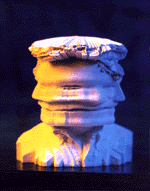|

My work bridges traditional studio concerns and digital media. I am interested in the gap between the virtual space of the computer and the tangibile, body-felt reality of sculptural objects.
I am a Professor of Intermedia within the School of Art at Arizona State University and Co-Director of the PRISM lab--an interdisciplinary 3D modeling and rapid prototyping facility. I also coordinate the foundation program in basic art instruction (artCORE) and Co-Direct an alternative art program called Deep Creek Arts in Telluride, Colorado. Selected Projects and Exhibitions The Interactive Watershed includes a series of physical and computer-based works flowing from a "participatory mapping project" conducted by the artist in the San Miguel River basin in Southwestern Colorado. A suite of interactive mapping tools (GIS based), graphic elements, and sculptural objects invite local participation related to "placemaking" and watershed education. Exploring Grand Canyon, a collaboration with artist and visualization specialist Gene Cooper, is an interactive exhibit that combines a tangible interface with screen-based experiences. It was recently installed at the Arizona Science Center. Mirage, an interactive video installation, was one of eight projects for the inaugural exhibition of the Tempe Art Center entitled But It's a Dry Heat. The project encourages visitors to the Tempe Art Center to reflect on their relationship to water in the desert. An 9 x 12 foot computer generated image of water is projected onto the floor of the gallery. When a viewer steps into this virtual pool of water, their presence is registered by a computer-controlled sensing system. The show, curated by Michelle Dock, ran from Sept. 9, 2007 - Jan. 11, 2008. Flooding Phoenix, a digital video sculpture, was featured at the ASU Art Museum from Sept. 9, 2006 - Jan. 27, 2007. For more information about the overall exhibition, see the New American City website. I Cannot Tell a Lie. This anamorphic video sculpture was part of the Democracy in America exhibit at the ASU Art Museum, August 31 - November 19, 2004. Return to the Garden, a 20 year retrospective, ran from December 12, 2003 - February 29, 2004 at the Tucson Museum of Art. The exhibition included a new project involving " networked surveillance ," several anamorphic installations, graphic works, and a range of digital sculptures. A review of the exhibition appeared in the October 2004 issue of Art in America. TeleSculpture (1999, 2000, 2001, 2003, 2005, 2007) were exhibitions and colloquia linking tele-communication with computerized rapid prototyping. 3D models transmitted in digital form via the Internet were translated into physical,"real-world" sculptures. The submission page continues to be open to all sculptors working in 3D digital media. Forgetting Ourselves and other sculptures were shown at the Boston Cyberarts Festival, Boston Computer Museum, May 1 - 15, 1999 Re-Call of the Wild (1998) was an installation that combined found objects and closed circuit video to probe our conflicted relationship to Nature. (Re)Inventing the Wheel (1997) was an installation that explored the history of technology through a number of different technological systems: rapid prototyping, video surveillance, and the Internet.
My research of the past few years has been focused upon recent technical advances in 3D digital imaging technologies. My research has included to date: a) working with "input" devices such as 3D laser scanners (at Cyberware in Monterey, CA) and various medical diagnostic tools (CT, MRI), b) becoming more adept at various 3D software modeling programs such as Form Z, Maya, Rhino, etc, c) learning more about methods of "output" such as CNC milling, stereolithography, laser sintering, and fused deposition modeling. I am currently in the midst of working with researchers from across the university on an interdisciplinary 3D visualization project called PRISM (Partnership for Research in Spatial Modeling) . PRISM links research in disciplines as diverse as Industrial Technology, Archaeology, Anthropology, Biomechanical Engineering, Bioscience, Computer Science, Architecture, Industrial Design, and Sculpture. It is a strategic research focus project funded in part by the Office of the Vice President for Research. For several years I have been involved with SIGGRAPH (Special Interest Group Graphics), an arm of ACM (Association for Computing Machinery). For the annual conference in the summer of 2001, held in San Antonio, Texas, I was chair of a venue called the STUDIO. The STUDIO is a creative environment that encourages SIGGRAPH attendees to work with the latest technologies for 2D and 3D production, animation, and VR.
I am involved in two areas of teaching in the School of Art at Arizona State University: Studio Core Foundation and our Intermedia program. I am interested in the role the computer can play with respect to beginning design instruction. Though many of the problems I have used in beginning studio art courses have utilized the computer, by in large we have resisted any moves towards a total "digitization" of our art courses and instead favor a kind of hybrid stance between traditional hand skills and the use of new technologies. We have developed a web-based resource for our Foundation program called artCore. I teach both studio and theory courses within the Intermedia area. Among the courses I have developed are "Issues in Intermedia," a theory-based seminar on contemporary practice and "3D Visualization and Rapid Prototyping," also called Visual Prototyping. I also advise a number of the graduate students in our MFA program in Intermedia as well as sit on graduate thesis committees.
I continue to involve myself in the research and publication of theoretical texts that reflect the larger concerns of my studio practice and my teaching. Click the link on bibliography to access the complete texts of several of my published papers in art, technology, and education. All rights reserved. I am currently a doctoral candidate in the College of Education at Arizona State University in the area of Educational Technology. The program is part of the Indisciplinary Humanities PhD in Curriculum and Instruction.
Dan Collins last updated: April 2008 |